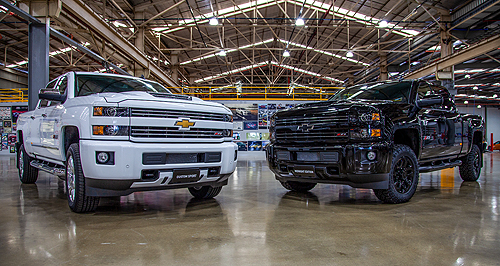News - ChevroletTwo shifts for RHD Chev Silverado lineLining up: Walkinshaw Automotive Group workers convert American-made Chevrolet Silverados to right-hand drive for Australia and New Zealand at the company’s Victorian factory. Walkinshaw Automotive factory working two shifts to convert Chevrolet Silverados31 Jul 2018 WALKINSHAW Automotive Group’s right-hand-drive vehicle conversion factory in Victoria is working two shifts a day as it ramps up production of the Chevrolet Silverado for Australia and New Zealand at the new Walkinshaw Park facility in Clayton South.
The Silverado line is producing up to six of the big American Silverado 2500HD pick-ups a day – three each shift – with each truck taking 16 hours in the RHD production process.
A total of 70 workers – some of them former Toyota production workers made redundant last year – are manning the shifts on the Silverado line, with the first shift running each weekday from 7am until 3.30pm and the second shift from 3pm to 11.30pm.
The Silverado line is under the same roof as a similar line producing rival Ram pick-ups. While the Silverado is marketed through Holden Special Vehicles (HSV) and its 55-dealership network, the Rams are built for independent importer Ateco Automotive and its separate retail network.
Right next to the Silverado and Ram production lines, a third line is being prepared for the RHD conversion of a third model line – Chevrolet’s Camaro sports coupe – from late August.
And in a separate facility within Walkinshaw Park, Holden Colorado SportsCat utes are being dressed for Holden showrooms.
In all, Walkinshaw Automotive and HSV have 250 workers at the facility, showing there is life after death of the Australian mass-production car industry that ground to a halt with the closure of Holden and Toyota factories in October last year.
While the scale is small compared with those major operations, the principle is the same, with engineering, design, production, sales and marketing disciplines all involved.
Several parts suppliers facing a bleak future have also found a new outlet for their components, with Walkinshaw sourcing items such as cast-iron steering boxes, steel stampings, plastic mouldings and even complete dashboard covers from Australian sources.
Walkinshaw production manager James Seath told GoAuto that shipments of Silverados were arriving from the United States in batches of 40 to 50.
He said the conversion process started by completely removing the crew-cab body from the rolling chassis – a process that requires disconnecting all the electrics and plumbing, as well as the bolts that secured the cabin to the heavy steel frame in a process taking 1.5 hours.
Mr Seath said the body and chassis then went down separate production lines.
On the body line, the interior is gutted, with the dashboard, heating and air-conditioning, pedals, seats and even the headlining and carpet removed so the conversion can begin with a clean slate.
The parts are all labelled so that later, when the process of assembly starts, all the original bits meet up. This ensures all the parts can be tracked so that the original integrity of the vehicle is maintained in case, for example, a safety recall is made.
While parts such as the dashboard, steering and HVAC (heating, ventilation and air-conditioning) units go next door to the sub-assembly area for reconfiguration into right-hand-drive items, others such as wiring harnesses go off to outside suppliers for modification.
Where possible, original parts are reused to save money. However, completely new parts – mostly from Australian suppliers – have to be ordered where conversion is not possible.
The next step is to cut strategic new holes in the dashboard for the RHD components and then weld about 16 new steel plates into place. These are then sealed to avoid rust, and finally painted.
The reassembly process then starts. This includes new tail-light lenses and seatbelts to meet Australia’s unique design rules.
On the chassis line, workers have been busy removing left-hand drive steering box and preparing mountings to take the locally produced RHD version.
Some engine parts have to be moved to create a clear path for the steering column through the tight mechanicals – a process that clearly was not in the original engineering brief in Detroit (but will be in future if Walkinshaw engineers have a say in it).
Ultimately, the body is remarried with the chassis and all the umbilical cords reconnected.
The last stop on the line is the liquids refilling station, where coolant, diesel fuel and other liquids are piped into the vehicle before a test driver starts it up and takes it for a quick test drive around the outside of the factory on a route that includes a rumble strip to check for squeaks and rattles.
HSV hopes to make and sell between 500 and 1000 Silverados for Australian and NZ customers in a full year. At the current production rate, about 750 will be made in 2018.
While the production process of the Silverado and Ram trucks is similar, the Camaro with its monocoque construction has required Walkinshaw Automotive to reinvent the process.
Because the body cannot be separated from the chassis, the production will involve a series stations, each with a hoist to do various processes.
Like the Silverado, the Camaro production start-up is running a little later than planned as engineers perfect the process so that each RHD car comes out looking like it came from the American factory like that.  Read more |
Click to shareChevrolet articlesResearch Chevrolet Motor industry news |

















Facebook Twitter Instagram